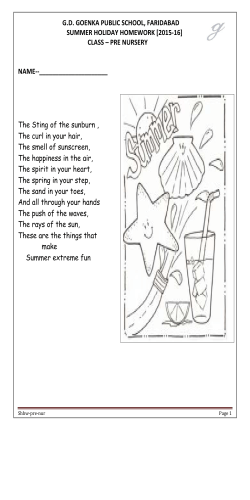
Removal of Color Blindness Using Image Segmentation
Volume 5, Issue 3, March 2015 ISSN: 2277 128X International Journal of Advanced Research in Computer Science and Software Engineering Research Paper Available online at: www.ijarcsse.com Special Issue: E-Technologies in Anthropology Conference Held at Bon Secours College for Women, India Removal of Color Blindness Using Image Segmentation R. Ranjani, Research Scholar, Department of Computer Science, Mother Teresa Women‟s University, Kodaikanal Dr. M.P. Indra Gandhi, Assistant Professor (SG), Department of Computer Science, Mother Teresa Women‟s University, Kodaikanal Abstract- Color blindness deficiency is the inability or decreased ability to see the color, under normal lighting conditions. There is no actual blindness but there is a deficiency of color vision. Color blindness is of many types like Red-Green, Blue-Yellow etc.., In this paper we proposed a new method that the users used the histogram thresholding to create a green colour mask which when they applied on the original image. KEY WORDS: Color Blindness, LMS Value, Color band, Threshold, Green Mask, Modify Image. I. INTRODUCTION Color blindness is a color vision problem where person is deficient to recognize colors like red, green and blue. There are different causes of colour blindness. For the vast majority of people with deficient colour vision the condition is genetic although some people become colour blind as a result of other diseases such as diabetes and multiple sclerosis or they acquire the condition over time due to the aging process, medication etc. To see anything at all we need some tiny little helpers inside our eyeballs, the so called photoreceptors. There are two different types of them: rods and cones. Both of them are sitting on the retina and pass information of light on to our brain. There are about 120 million rods which are very sensitive to light but not to color. The cones are the photoreceptors which are responsible for our color vision. There are three types of cones are: S-cones: sensitive to short wavelength light with a peak at ca. 420nm (blue) M-cones: sensitive to medium wavelength light, peak at ca. 530nm (green) L-cones: sensitive to long wavelength light, peak at ca. 560nm (red) This type of color blindness is usually a sex-linked condition. The genes that produce photo pigments are carried on the X chromosome; if some of these genes are missing or damaged, color blindness will be expressed in males with a higher probability than in females because males only have one X chromosome (in females, a functional gene on only one of the two X chromosomes is sufficient to yield the needed photo pigments). There are different types of color blindness Monochromacy: There is no cone or only one type of cone present at retina of eye. It is called Monochromacy. Dichromacy: There are only two types of cones present at retina of eye. It is called Dichromacy. Dichromacy is again of three types according to missing cone: Protanopia: L-cone missing is called protanopia. So the person suffered from protanopia is unable to see red color. This is called „Red blindness‟. Deuteranopia: M-cone missing is called Deuteranopia. So the person suffered from deuteranopia is unable to see green color. This is called „Green blindness‟. Tritanopia: S-cone missing is called Tritanopia. So the person suffered from tritanopia is unable to see blue color. This is called „Blue blindness‟. Anomalous Trichromacy: In anomalous trichromacy all three cones are present but one of these cones perceives color slightly. It is of three types depending upon which cone is working improperly: Protanomaly: Defective of L cones and sensitivity to red hue is lower. This is called „Red Weakness‟. Deuteranomaly: Defective of M cones and sensitivity to distinguish red and green hue is lower. This is called „Green Weakness‟. Tritanomaly: Defective of S cones and sensitivity to distinguish blue and yellow hue is lower. This is called „Blue Weakness‟. Red-green color blindness Red-green color blindness is a type of deficiency of color vision where sensing of red and green color is weak. Red-green color blindness term is used for Protanopia, Deuteranopia, Protanomaly and Deuteranomaly. Blue-yellow color blindness Blue-yellow color blindness is a type of deficiency of color vision where sensing of blue and yellow color is weak. Blue-yellow color blindness term is used for Tritanopia, Tritanomaly. © 2015, IJARCSSE All Rights Reserved Page | 201 Ranjani et al., International Journal of Advanced Research in Computer Science and Software Engineering 5 (3), March- 2015, pp. 201-204 II. PREVIOUS WORK RGB to HSV conversion: As process starts first web contents are extracted from the websites and then out of these contents some images that are to be transformed are selected and saved. After saving these extracted images are passed through the colour transformation process, by which unrecognized colours are transformed to recognizable colors to the color blind person. This research focuses on the red-green colour vision deficient. Transformation process result as red is transformed to yellow and green is transformed to blue and blue is remaining same [2]. Green color‟s range is 120° because its hue value comes between 60° to 180°. Blue color‟s range is 180° to 300° because its hue value comes between 180° to 300° [4]. Green Ratio = (Hue - 60) / Green Range. RelativeBlue = GreenRatio x BlueRange Hue value after the transformation process is Hue = 180 + BlueRatio After transformation hue value is divided by 360° for HSV to RGB conversion. Hue = Hue / 36.Gradient map method is an approach that is able to indicate regions that encounter the accessibility problem for colorblind viewers, the regions contain information that may not be well perceived by color blind This method can be applied in different scenarios, such as checking the accessibility of designed images and to help designers to avoid the accessibility problem by making changes on the image[5]. Dalton Method performs that, different color image has been found useful to visually inspect perceived colour difference and additionally to build colour remapping methods. Two colour transformation methods are presented [1]. This research focused on two types of dichromacy (protanopy and deuteranopy).In this some methods are described as Image simulation, color transformation using color difference, color transformation using color difference scaling, color transformation using red/green scaling. LMS space plane is defined as: αL + βM + γS = 0.The basic idea is first to find the LMS values of the RGB (red-greenblue) image using some conversion matrix. Then a conversion is made to delete the information associated with the loss of any of the cone type to get the modified LMS values L‟M‟S‟.Then reverse transformation is done on the L‟M‟S‟ values to get the R‟G‟B‟ values. Now R‟G‟B‟ values represent that how the specific color RGB is perceived by a color blind person. When this operation is done for all the pixels, the image is converted. This linear transformation can be achieved by a matrix multiplication [8].For each pixel do Gamma correction [R, G, B]= [R/255, G/255, B/255]^2.2 Principal Component Analysis (PCA) technique that takes a collection of data and transfer in that manner the new data has a given statistical properties. Seperating confusion line method in color space is using color segmentation for protanopia and deuteranopia. In the huge part of the image is used CVD making a confusion line map, 512 virtual boxes in RGB color space.After that classify the confusion line check the region place that is belong to confusion line or not that is calculate by the seed points and the histogram. It performs the color transformation in CIE Lab color spaces [6]. Color Blind Plate(CBP) The image segmentation and pattern recognition to color blindness plate. The CBP is wellknown satisfactory way of testing the degree of color blindness happened in the human visual system. The image of CBP is very complex. It includes not only the colors but also the disconnected size-varied dots. It is very difficult by using a conventional machine vision algorithm to recognize the meaningful pattern (ex: figure) from such a CBP image.1) Passive Process : CBP Segmentation 2) Active Process: CBP Recognition[3].CCPS is a measure of the percentage of pixels in an image that change color category when viewed by individuals with dichromatic color vision. RCCPS is a measure of how many pixels change color category in each color category. CCPS provides an overview of how much pixel change occurs, RCCPS provides details about which Color categories undergo changes along with how much per category. Both the CCPS and RCCPS measures rely on image transforms as part of the process of generating the measures [7]. 𝑆ℎ𝑖𝑓𝑡𝑒𝑑 𝑃𝑖𝑥𝑒𝑙𝑠 𝐶𝐶𝑃𝑆 = ∗ 100 𝑇𝑜𝑡𝑎𝑙 𝑃𝑖𝑥𝑒𝑙𝑠 (𝐶𝑃𝑂 − 𝐶𝑃𝑇) 𝑅𝐶𝐶𝑃𝑆 = ∗ 100 𝑇𝑜𝑡𝑎𝑙 𝑃𝑖𝑥𝑒𝑙𝑠 III. METHODOLOGY In this paper we propose a new technique to remove color blindness to make image visible to the color deficient person. This approach has following processes:Image simulation Find the LMS values of the RGB (red-green-blue) image using some conversion matrix. Then a conversion is made to delete the information associated with the loss of any of the cone type to get the modified LMS values L‟M‟S‟. Then, reverse transformation is done on the L‟M‟S‟ values to get the R‟G‟B‟ values. Now R‟G‟B‟ values represent that how the specific color RGB is perceived by a color blind person. When this operation is done for all the pixels, the image is converted. This linear transformation can be achieved by a matrix multiplication. Thresholding Thresholding is the process of extracting all the pixels in an image that lie within a specific range of colors. Color information of each pixel in an image is typically represented as a point in a 3 dimensional space. In color images each pixel is characterized by the three RGB values. Then to construct a 3D histogram and the basic procedure is analogous to the method used for one variable. Histograms plotted for each of the color values and threshold points found. Creating green mask Using the threshold value the green region of an image can be masked. Modifying image After the masking, the particular region of an image is converted to purple using matrix value. Modifying matrix (M) is given as © 2015, IJARCSSE All Rights Reserved Page | 202 Ranjani et al., International Journal of Advanced Research in Computer Science and Software Engineering 5 (3), March- 2015, pp. 201-204 0.5 0.1 0 0 0 0 0.9 0 0.1 This matrix is multiply with each pixel on the original image. IV. EXPERIMENTAL RESULTS Figure 1:Original Image Figure 2: Image Seen by person suffering from Deutenophia Figure 3: Modified image Figure 1: Original Image, Figure 2: Image Seen by person suffering from Deutenophia, Figure 3: Modified Image shows that the process is successful in modifying the images for colour blindness. The colour confusion of green is clearly solved. This process takes 1.972 seconds to execute. V. CONCLUSION The proposed work shows the accurate results of the images for the color blindness. This procedure is very useful for color blindness. Applying the morphological process based on the histogram value the original image is converted into modified image. The green color has been converted into purple color as shown in Figure 3. VI. FUTURE SCOPE This work can be extended for various shades of green color and protanopia, tritanopia with blue and yellow color. REFERENCES [1] J.B. Huang, Y.C. Tseng, S.I. Wu, and S.J. Wang, “Information preserving color transformation for protanopia and deuteranopia,” IEEE Signal Processing. Lett., vol. 14, no. 10, Oct,2007. [2] Kim, Y. K., Kim, K. W. and Yang, X., “Real Time Traffic Light Recognition System for Color Vision Deficiencies”, Mechatronics and Automation (lCMA), International Conference, pp. 76-81, 2007 [3] Jacek Ruminski, Jerzy Wtorek, Joanna Ruminska, Mariusz Kaczmarek, Adam Bujnowski, Tomasz Kocejko, and Artur Polinski, “Color Transformation Methods for Dichromats”, Human System Interactions (HSI), 2010 3rd Conference, pp: 634 - 641, 2010 [4] Siew-Li Ching and Maziani Sabudin, “Website Image Colour Transformation for the Colour Blind”, Computer Technology and Development (ICCTD), 2010 2nd International Conference, pp. 255 - 259, 2010 [5] J.P.Srividhya, P.Sivakumar and Dr.M.Rajaram , “ The color blindness removal technique in image by using gradient map method”, Signal Processing, Communication, Computing and Networking Technologies (ICSCCN), 2011 International Conference, pp: 24 - 29, 20 © 2015, IJARCSSE All Rights Reserved Page | 203 Ranjani et al., International Journal of Advanced Research in Computer Science and Software Engineering 5 (3), March- 2015, pp. 201-204 [6] Jinsan Park, Jongho Choi, Dongil Han “Applying enhanced confusion line Color transform using Color segmentation for mobile applications”, IEEE ,2011 [7] Mike Bennett and Aaron Quigley Imaging, “A Method for the Automatic Analysis of Color Category Pixel Shifts During Dichromatic Vision”, Visualization & Graphics Lab Systems Research Group, 2012. [8] Ruchi Kulshrestha, R.K. Bairwa, “Removal of Color Blindness using Threshold and Masking”, International Journal of Advanced Research in Computer Science and Software Engineering, Volume 3, Issue 6, June 2013 © 2015, IJARCSSE All Rights Reserved Page | 204
© Copyright 2025









